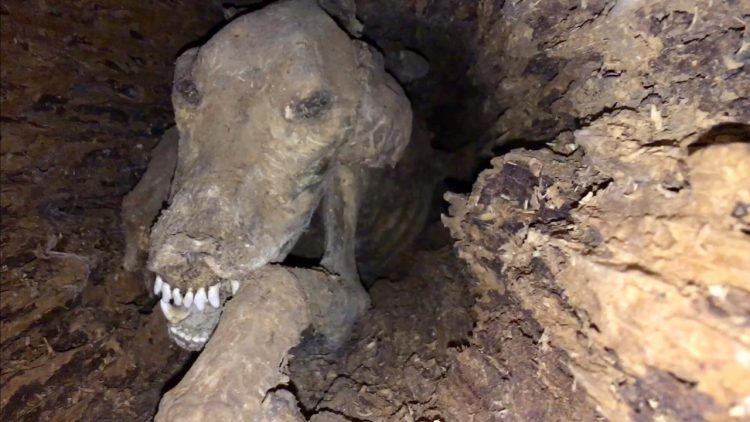In 1980, when loggers for the Georgia Kraft Corp. cut a chestnut oak into logs they made a grim discovery. Lodged in a hollow stretch near the top of the tree was a mummified hunting dog. Rather than send the section of the tree on to the sawmill, the loggers donated it to Forest World, a tree museum in Waycross, Georgia. He has been a star attraction ever since.
The dog, named (slightly insensitively) “Stuckie” after a 2002 naming contest, had apparently been in the tree for approximately 20 years before the loggers discovered him. Experts believe that he had probably chased after some small game, wedging himself into the hollow tree and climbing a whopping 28 feet up before getting stuck.

Photo: YouTube screengrab
“People always ask me, ‘How did he get in there?’,” said Brandy Stevenson, Forest World’s manager, told Roadside America. “And I always say, ‘Well, he was a hound dog. Maybe he was after a coon.’ And then they’ll say, ‘Poor old thing. I feel so sorry for him.'”
How the hound became mummified inside the tree instead of rotting is a much more interesting question, though. Usually, when an organism dies, the microorganisms in the body are left unchecked by the biological processes that keep them under control in living creatures. They begin to consume the body, and then the gut microorganisms start the process of putrefaction. The corpse bloats and decays, attracting bacteria, fungi, insects and other animals come to eat the remains.
“They grow, they reproduce, and they start taking over the body, that’s the disgusting part” said Kristina Killgrove, a biological anthropologist at the University of West Florida
Stuckie, however, was spared this fate, “thanks” to the nature of the trap that ultimately killed him. The factors that led to his mummification are explained on a plaque beside the Stuckie exhibit at the Forest World Museum:
“A chimney effect occurred in the hollow tree, resulting in an upward draft of air. This caused the scent of the dead animal to be carried away, which otherwise would have attracted insects and other organisms that feed on dead animals. The hollow tree also provided relatively dry conditions, and the tannic acid of the oak helped harden the animal’s skin.”
Tannin is a natural “desiccant,” a substance that absorbs moisture and dries out its surroundings. The low-moisture environment stopped the microbial activity, Killgrove explains, which meant no decay. Thus poor Stuckie’s body was preserved in a remarkably good condition.
If you want to see Stuckie the mummified dog in person, you can find him at the Southern Forest World Museum and Environmental Center in Waycross, Georgia. The museum is open Tuesday to Saturday, from 9 am to 2 pm.













